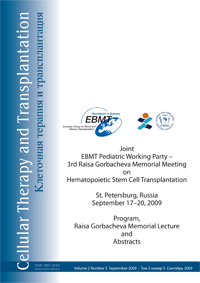The comparative characteristic toxicity and immunosuppressive activity both tacrolimus and cyclosporine in patients undergoing allo-HSCT
Yulia A. Stankevich, Ludmila S. Zubarovskaya, Elena V. Semenova, Sergey M. Alexeev, Elena V. Babenko, Boris V. Afanasyev
Memorial R. M. Gorbacheva Institute of Children Hematology and Transplantation, St. Petersburg Pavlov State Medical University, St. Petersburg, Russia
Correspondence
Memorial R. M. Gorbacheva Institute of Children Hematology and Transplantation, St. Petersburg Pavlov State Medical University, 6/8, Tolstoy str., St. Petersburg, 199044, Russia
E-mail: juliastan@mail.ru
Summary
Background
Graft-versus-host disease (GVHD) still remains one the major obstacles to successful allogeneic hematopoietic cell transplantation (HSCT). GVHD is a major cause of morbidity and mortality even when the recipient and donor are matched at the major histocompatibility complex. In its acute and chronic forms, GVHD has an important impact on survival and the recipient’s quality of life. The ability to prevent GVHD – i.e., the application of successful prophylaxis – is the cornerstone of success. Immunosupression with pharmacological agents such as cyclosporine (CsA) or tacrolimus (Tx) is more often used for GVHD prophylaxis. Because they share a common intracellular target, the toxicity profiles of CsA and Tx are very similar. We found Tx to be superior for the prophylaxis of acute GVHD, but more toxic. While hypertension and myelosupression is more commonly seen with CsA, neurological, nephrology, and gastrointestinal side effects are more often associated with the administration of Tx.
Patients and methods
From 2000 to December 2008, 171 patients (pts) received allogeneic HSCT. In two patients allo-HSCT was repeated because of relapse of disease, so the total number of transplantations was 173. Patients and donor characteristics, type of allo-HSCT, and preparing regimens are shown in Table 1.
Results
There was no significant difference in survival. The 6-month overall survival rate was 53% for the Tx group and 65% for the CsA group; the 6-month relapse-free survival rate was 42% (Tx) vs. 50% (CsA). There was no difference in rates of relapse between the two groups.
Infections were the most common cause of death, accounting for 33% of deaths. Other causes of death included acute GVHD (31%), relapse (20%), and multisystem organ failure (8%). The incidence of infections was similar in the two study groups.
Although a significantly greater proportion of patients was treated with cyclosporine, the incidence of grades II-IV acute GVHD was significantly lower in patients who received tacrolimus (29% vs. 54% in related HSCT and 32% vs. 60% in unrelated HSCT).
Despite the fact that Tx proved to be superior as a prophylaxis of acute GVHD, it was found to be more toxic. The incidence of hypertension was significantly higher in the CsA group (38% vs. 24%), but neurological complications (headache, tremor, paresthesia) were significantly higher in the Tx group (44% vs. 30%). Gastrointestinal disturbances were more common in the Tx group (46% vs. 36%, NS), as was hyperglycemia (24% vs. 16%), nephrotoxicity (19% vs. 15%), and metabolic disturbances (11% vs. 7%).
Conclusion
The use of Tx seems to be preferable in groups with a higher risk of developing GVHD because it has a more potent immunosuppressive effect. But Tx has more toxic complications such as neurological, nephrology, gastrointestinal, and metabolic disturbances. On the other hand, hypertension and myelosuppression is more commonly seen with CsA.
Keywords
graft-versus-host disease, allogeneic hematopoietic cell transplantation, immunosuppressive therapy
Table 1. Patient’s and transplant’s characteristics
| Number of patients | ||
| Number of allo-HSCT | 173 | |
| Related HSCT | 64 | |
| Unrelated HSCT | 109 | |
| Haploidentical HSCT | 17 | |
| Patients age median, y (range) | 31.6 (14–66) | |
| Diagnosis | ||
| AML/MDS | 57/7 | |
| remission | ||
| relapse | ||
| ALL | 58 | |
| remission | ||
| relapse | ||
| Lymphoma (NHL+HD) | 16 | |
| CML | 25 | |
| chronic phase | ||
| acceleration phase | ||
| Aplastic anemia | 6 | |
| Other | 4 | |
| Source of HSC | ||
| BM | 57 | |
| PBSC | 99 | |
| BM + PBSC | 17 | |
| HLA | ||
| full match | 118 | |
| 1 mismatch | 28 | |
| 2 mismatch | 10 | |
| haplo | 17 | |
| Prophylaxis of GVHD | ||
| CsA + MMF | 14 | |
| CsA + Mtx | 83 | |
| CsA + Mtx + MMF | 6 | |
| Tx + MMF | 46 | |
| CsA | 8 | |
| Other | 12 | |
| Myeloablative regimen | 47 | |
| Nonmyeloablative regimen | 125 | |
| ABO-compatibility | 71 | |
| ABO-incompatibility | 102 | |
| Sex-compatibility | 92 | |
| Sex-incompatibility | 81 | |
| Transplanted donor cells | ||
| NC x 10 8/kg | 6.7 n=19 (2.6–14.4) | |
| CD34 x 10 6/kg | 5.13 n=21 (0.3–18.3) |


